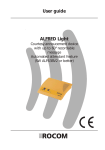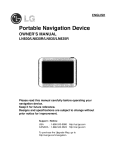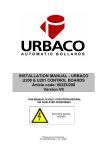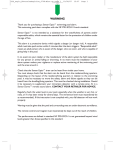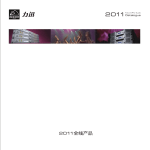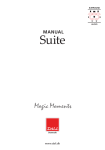Download User guide Alfred Light
Transcript
User guide ALFRED Light User guide Issue 1.00 ALFRED Light Courtesy annoucement device with up to 60" recordable message Automated attendant feature Page 1 User guide ALFRED Light Issue 1.00 Contents Description ............................................................................ 3 Connection diagram ............................................................. 5 Configuration examples ....................................................... 6 Front panel view ................................................................... 9 Rear panel view ................................................................... 10 Features ............................................................................... 11 Installation .......................................................................... 11 Programming ...................................................................... 13 Activate programming mode ............................................. 13 Telephone number programming ....................................... 14 Telephone number deleting ................................................ 15 Answer delay programming ............................................... 16 Flash signal time programming .......................................... 17 Numbering plan digit number programming (automated attendant) ....................................................................... 18 Default configuration data load ......................................... 19 Message recording.............................................................. 20 Message recording from CD, MC or mixer ......................... 21 Play back ............................................................................. 22 Technical data ..................................................................... 23 Page 2 User guide ALFRED Light Issue 1.00 Description ALFRED Light is a digital announcement device with the following features: - Courtesy announcement The device must be connected to a analouge PABX extension line. This port has to be programmed on the PABX to receive, using features like call diversion or call rerouting, all calls which can not be answered by the attendant or other extensions. Depending on the required function the calls can be diverted to ALFRED Light only if the attendant or the extension is busy, doesn't answer within a specific time or in any case. With small PABX were call diversion or call rerouting features are not available the device should be programmed to receive incoming calls at the same time as the attendant. You can program then a call answer delay on ALFRED Light giving enough time to the attendant to aswer the call if he/she is free. After answering the call the device can send an up to 60" long message. The message can be recorded by the user itself using the build in microphone or an external source like a CD or MC player. At the end of the message the device will send a flash signal, followed by an up to 16 digit long telephone number. This will connect the answered call back to the attendant, or other extension. Now the external call will be placed in the waiting queue of the PABX. - Automated attendant This feature can be activated by programmation. With this feature activated the caller party can be invited, during the greeting message, to dial a specific internal number using his DTMF dial pad. If the caller will follow the instruction, the device wil stop the outgoing message as soon as a valid DTMF digit is detected. At the end of the dial ALFRED Light will transfer the call to the dialed number and not to the stored one. The device will not survey the dialed number. Only the number lenght is programmed in the device. This gives a high grade of flexibility in the possible applications of this feature. To ensure that the external caller may not activate PABX features or external calls, the extension line with the connected ALFRED Light should be restricted using the class of service programmation of the PABX. Page 3 User guide ALFRED Light Issue 1.00 If the caller doesn't dial a number, or if the dialed number is shorter then the programmed lenght, the device will forward the call the the programmed extension at the end of the message or after a time out. - Digital announcement device If no telephone number is programmed, the device will work as a digital annoucement device. After the message the connection will be released. The following programmations can be done on the ALFRED Light: - 1 to 16 digits long telephone number (0 bis 9, *,#) - Delay on answer (0 to 99 calls) - Flash signal duration (0 to 999 ms) - Internal numbering plan lenght (1 to 16 digits) The programmation is done using DTMF dial signals. For this procedure ALFRED Light has do be called, after the programming mode has been activated. After the answer you will receive a acknowledge tone and the programmation can be done using a DTMF dial pad. Follow the instructions on the following pages. The message is stored on a EEPROM memory using the DAST procedure. This memory is protected against loss of data due to power failure for a period of ten years. The message can be recorded using the build-in microphone or an external source. The message volume can be regulated. The output inpedance is about 600 Ohm. The power supply is provided by the attached plug PSU. Page 4 User guide ALFRED Light Issue 1.00 Connection diagram Page 5 User guide ALFRED Light Issue 1.00 Configuration examples Example 1. Courtesy announcement with busy attendant - Call diversion on busy feature is activated for the attendant. - If the attendand is busy the call is diverted immediatly to ALFRED Light. Example 2. Courtesy announcement with no answer - Call diversion after time is programmed for the attendand/extension. - The call is forwarded to ALFRED Light only if the attendand/extension doesn't answer. Page 6 User guide ALFRED Light Issue 1.00 r a ll tr a n s f e Inc om ing c all C Example 3. Courtesy announcement with no answer or busy attendant - Attendant and ALFRED Light are called at the same time. - The call will be answered by ALFRED Light only after a programmed delay. Example 4. Courtesy announcement with busy operator and automated attendant - Call diversion on busy feature is activated for the attendant. - If the attendant is busy the call is diverted immediatly to ALFRED Light. - The waiting caller can dial during the message an internal number using the DTMF dialpad. Page 7 User guide ALFRED Light Issue 1.00 Example 5. Automated attendant - Alfred Light is programmed to receive all incoming calls. - The caller can dial during the message an internal number using the DTMF dialpad. - If no number is dialed the caller will be connected to the attendant. Night s ervice Example 6. Night message - Alfred Light is programmed as night answer machine. - The call will be answered immediatly. At the end of the message the connection will be released. Page 8 User guide ALFRED Light Issue 1.00 Front panel view PROG Alfred PROG key for the switch to p rogramm ing / record ing mode . W ith m ultiple device configurations this key is enabled only on the maste r device. REC /STOP key for the re cording of the m ess age from m icropho ne or external source. The key is enab led onl y duri ng the recording m ode (LED is flshing orange). The record will be started at the rel ease of the button. Pressing the button a s econ d time will stop th e re cording and store the m essage.. LED indicato r: - Green flashing : stand by - Orange flashing: prog ram m ing/recording function - Re d: recordi ng - Re d flashing: 5 seco nds to the e nd of recording tim e - Green: answer m ode Volum e con trol of the mes sage send to the te lephone line. The build in l oudspeaker doe sn 't have a volum e control. PLAY key for the p lay back o f the reco rded m essage . T he m ess age will be played autom atically at the e nd of the record, and after p ower on . Microphon e for the registration of the m essage. Mess ages on C D o r MC can also be record ed using the con nector JB on the back of the device. If this conn ector is use d the m icrophone will be disabled. Page 9 User guide ALFRED Light Issue 1.00 Rear panel view O N PW R JA JB JC L IN E Connector for telephone line cable Not used on Alfred Light Connector for the external so urce for the recording o f the messag e (CD, MC, Mixer, etc.). The build in microphone is disabl ed if this connector is used. Not used on Alfred Light Plug in for external power suppl y unit on/off switch Page 10 User guide ALFRED Light Issue 1.00 Features - On site recordable message - Build in microphone for on site message recording - Build in loudspeaker for the play back of the recorded message - Input for external source (i.e. CD, MC or mixer) to record the message - Courtesy annoucement service for quite any type of trunk and PABX - Up to 16 digits long programmable telephone number - DTMF dial - Programmable flash signal time from 0 to 999 ms - Programmable answer delay from 0 to 99 rings - Message output level control - Up to 60 seconds recordable message lenght - Programmation using DTMF dial - Automated attendant feature (DTMF dial in during message) - 230 Vac power supply with external unit - Small case - Nice shaped case - Fast and easy installation and programmation Installation The installation place of the device should be: - in a dry room; - far from dirt, heat an direct sun light; - far from device generating strong electromagnetical fields (like loudspeaker); - far from liquids and chemical agressiv substances. Before you start with the installation please note: - The device can be powered only with voltage indicated on the identification label. - The device doesn't contain maintanable parts and should be opened only by instructed technicians. - If a liquid should get into the device disconnect immediatly the power supply. The device should be opened only by instructed technicians. Page 11 User guide ALFRED Light Issue 1.00 - To polish the device use only a clean and soft cloth. To remove spots use a umid cloth or a natural cleaning substance. Do not use chemical substances or petrol, these might damage the plastic of the case. - Do not drop or shock the device. - Static discharge may damage the device. Ensure that you discharge yourself using a appropiate grounding before handling the unit. Installation - Connect the device to a telephone plug using the line cable. The PABX must be programmed to work together with the device. This procedure is different from PABX to PABX. For the normal use the extension line with the connected ALFRED Light should be programmed to receive incoming calls at the same time as the attendant during day service. Other type of programmations can use the call diversion features of the PABX. For a best service the PABX should have the feature "call waiting on busy extension", where an external call can be put on a waiting queue for a busy extension by a call transfer. - Connect the provided power plug to the device and into the mains plug. Switch the unit on. - After the play back of the stored message the device is ready to work. Herefore it has to be programmed first. To program the unit press the button PROG. The orange LED will flash fast. Call now the unit using a phone with DTMF dial pad. If you don't call the unit within 30 seconds, it will automatically switch back to the stand by mode (green LED slow flashing). In programming mode also the message can be recorded using the build in microphone or an external source. For the programming of the device and the recording of the message please read the following instructions. Page 12 User guide ALFRED Light Issue 1.00 Programming Activate programming mode To activate the programming mode press, using a pen or a small screwdriver the PROG button. The orange LED will flash fast. PROG Alfred Using a phone with enabled DTMF dial pad call the device using the internal telephone number of the extension line where the unit is connected to. The device will answer the call the send three short tones. The LED will be switched off as soon as the frist DTMF digit is recognized. After this the green LED will go shortly on with any recieved DTMF digit. After pressing the PROG button you will have about 30 seconds to call the device or to start with the recording of the message. If this will not happen the device will go back to stand by mode automatically (green LED flashing slow). In programming mode you might hear the following tones: - Input is correct: three tones - Input is wrong: six tones - Error in the device: nine tones The programming mode will be terminated dialing the digit 3, or automatically with no action within 30 seconds, or switching the unit off and on. With a multiple device configuration the programming and recording is done only on the master unit. This will then forward the information and message to the connected slave devices. Page 13 User guide ALFRED Light Issue 1.00 Telephone number programming The herewith programmed telephone number will be dialed at the end of the message after sending a flash signal. At the end of the dial the device will release the line. If no number is stored the unit will work as an answering maschine. At the end of the message the line will be released without dial. Activate the programming mode. See also page 16. PROG Alfred Call the device using a telephone with DTMF dial pad. You here three short tones. Dial now: * # 1 You here three short tones. Dial now the desired telephone number, max. 16 digits long. The DTMF digits * and # can be used also as part of the telephone number, but only as first digit ond only once. Dial at the end of the telephone number: * * You here three short tones. The telephone number is stored. You can now go ahead to program the following steps or terminate the programmation dial the digit 3. PLEASE NOTE! Some PABX can detect automatically if the telephone has a rotary dial or DTMF dial pad. The dial mode can be detected only if the dial is started without a flash signal. To ensure that with an Alfred connected to such a PABX the dial mode can be detected correctly the device will send the stored number without flash every time it will be switched on. At the first activation you should program the number and then switch the device off and on. This will ensure that the correct dial mode is setup at the PABX and you can check the correct stored number. Page 14 User guide ALFRED Light Issue 1.00 Telephone number deleting Without a programmed telephone number the device will work as an answer machine. At the end of the message the line will be released. This is the default configuration of the device. Activate the programming mode. See also page 16. PROG Alfred Call the device using a telephone with DTMF dial pad. You here three short tones. Dial now: * # 6 You here three short tones. The telephone number is deleted. You can now go ahead to program the following steps or terminate the programmation dial the digit 3. Page 15 User guide ALFRED Light Issue 1.00 Answer delay programming The device will wait for the programmed number of calls before answering. The default configuration is 00 calls: no delay. Activate the programming mode. See also page 16. PROG Call the device using a telephone with DTMF dial pad. You here three short tones. Dial now: * # 2 You here three short tones. Dial now the number of rings 00 to 99 to be waited before answering the call. Insert the value always with two digits! You here three short tones. The answer delay is programmed. You can now go ahead to program the following steps or terminate the programmation dial the digit 3. Page 16 Alfred User guide ALFRED Light Issue 1.00 Flash signal time programming Here you can program the flash signal (recall button) time for the connected PABX. A recall activation with ground button is not possible. The default configuration is 80 ms. Activate the programming mode. See also page 16. PROG Alfred Call the device using a telephone with DTMF dial pad. You here three short tones. Dial now: * # 3 You here three short tones. Dial now the flash signal time in milliseconds 000 to 999. Insert the value always with three digits! You here three short tones. The flash signal time is programmed. You can now go ahead to program the following steps or terminate the programmation dial the digit 3. Page 17 User guide ALFRED Light Issue 1.00 Numbering plan digit number programming (automated attendant) This programmation will activate the automated attendant feature. With this feature the waiting party can be invited to dial a DTMF number during the waiting message. If this will happen the device will wait until the here programmed number of digits are dialed by the calling party. After this it will terminate the message and forward the call to the dialed number. The device will NOT take any control of the dialed number. If no number is dialed the unit will forward the call to the programmed number. The default configuration is 00: no automated attendant feature. Activate the programming mode. See also page 16. PROG Call the device using a telephone with DTMF dial pad. You here three short tones. Dial now: * # 4 You here three short tones. Dial now the desired number of digits required by the numbering plan of the PABX from 00 to 16. Insert the value always with two digits! You here three short tones. The numbering plan digit number is programmed. You can now go ahead to program the following steps or terminate the programmation dial the digit 3. Page 18 Alfred User guide ALFRED Light Issue 1.00 Default configuration data load With this function you can reload the default configuration data as indicated. Activate the programming mode. See also page 16. PROG Alfred Call the device using a telephone with DTMF dial pad. You here three short tones. Dial now: * # 999 You here three short tones. The default configuration data are loaded. Only the programmed number will be maintened. You can now go ahead to program teh following steps or terminate the programmation dial the digit 3. Page 19 User guide ALFRED Light Issue 1.00 Message recording Activate the programming mode. See also page 16. PROG Press the REC/STOP button. The record will start as soon you release the button. The red LED will light. Speak your message as close as possible into the microphone. The record lenght is about 60 seconds. As the red LED will start flashing, you will have 5 secondes of recording time left. At the end of the recording time, or if you press the START/REC button again, the device will switch to play back mode and you can hear the recorded message on the internal loadspeaker. The green LED will light during the play back. At the end of the message the unit will go in stand by mode. The green LED will flash slowly. You can hear to the recorded message all time pressing the PLAY button. During the play back the green LED will light. Page 20 PROG PROG PROG PRO G Alfred Alfred Alfred Alfred Alfred User guide ALFRED Light Issue 1.00 Message recording from CD, MC or mixer Connect the external source to the JB plug on the back of the device. Activate the programming mode. See also page 16. Press the REC/STOP button. The record will start as soon you release the button. The red LED will light. O N PW R R S 232 JA PROG PROG JB JC L IN E Alfred Alfred Start the message paly back on the external device. The record lenght is about 60 seconds. As the red LED will start flashing, you will have 5 secondes of recording left. At the end of the recording time, or if you press the START/REC button again, the device will switch to play back mode and you can hear the recorded message on the internal loadspeaker.The green LED will light during the play back. At the end of the message the unit will go in stand by mode. The green LED will flash slowly. You can hear to the recorded message all time pressing the PLAY button. During the play back the green LED will light. PROG PRO G Alfred Alfred Page 21 User guide ALFRED Light Issue 1.00 Play back You can hear to the recorded message all time pressing the PLAY button. During the play back the green LED will light. After recording the message to your sadisfaction you can connect the device to the PABX. For any question about this matter refer to your technical support for the PABX. After the connection and programmation of the PABX test the installation calling the PABX and waiting until ALFRED will answer the call. With a small screwdriver you can now regulate the volume of the message level on the telephone line. If the message will still be too low, you should record the message again using a higher output level on the external device or getting closer to the microphone Page 22 Alfred PROG O N PW R R S 232 JA PROG JB JC L IN E Alfred User guide ALFRED Light Issue 1.00 Technical data D ES C RIP TION Dimensions Weight Power supply 140 x 180 x 38 mm (D,L,H) max. 400 g 12 Vdc; max. 400 mA Power supply unit 230 Vac +6 /-10%; 50 Hz; Signal output level max. -10,5 dB, regulated Output impedance 600 Ohm Bandwith Digitalisation Memory 300 bis 3400 Hz DAST, 8 kHz scanning frequency EEPROM, 10 years data retain Message lenght 60 seconds No. of messages 1 Enviroment Electical security Class of protection Electromagnetical immunity O° to +45°C; max. 90% umidity EN 60950 IP 30 DIN 40050 EN 60555-2, EN 55022, EN 50082-1 Page 23 © 2002 ROCOM GmbH. Product may change without notice. We do not respond for any errors or mistake in the present documentation. Printed in Germany. User guide Page 24 ALFRED Light Your dealer: Manufactured by: Energie- und Kommunikationssysteme GmbH Lessing Str. 20, 63110 Rodgau, Germany Tel. +49-6106-6600-0 Fax +49-6106-6600-66 E-Mail: [email protected] http://www.rocom-gmbh.de Issue 1.00

























